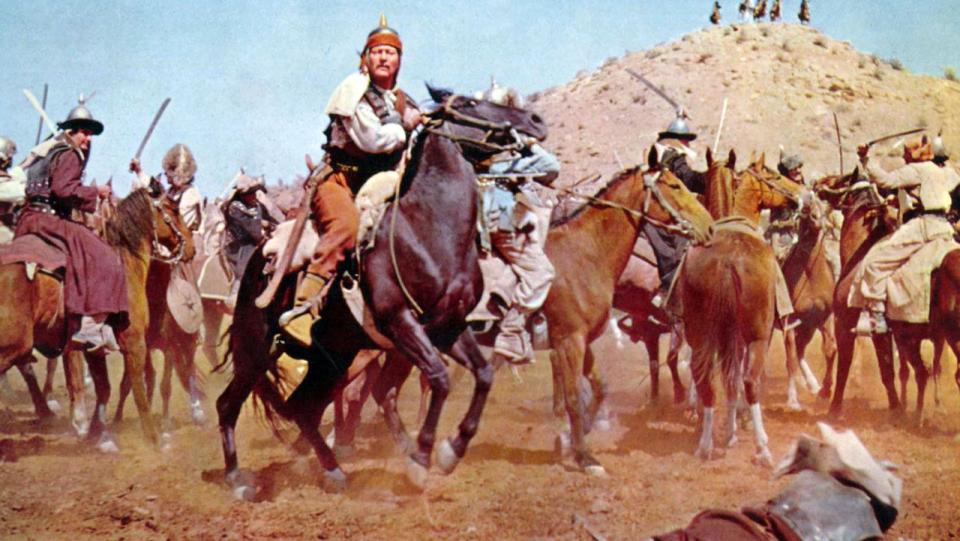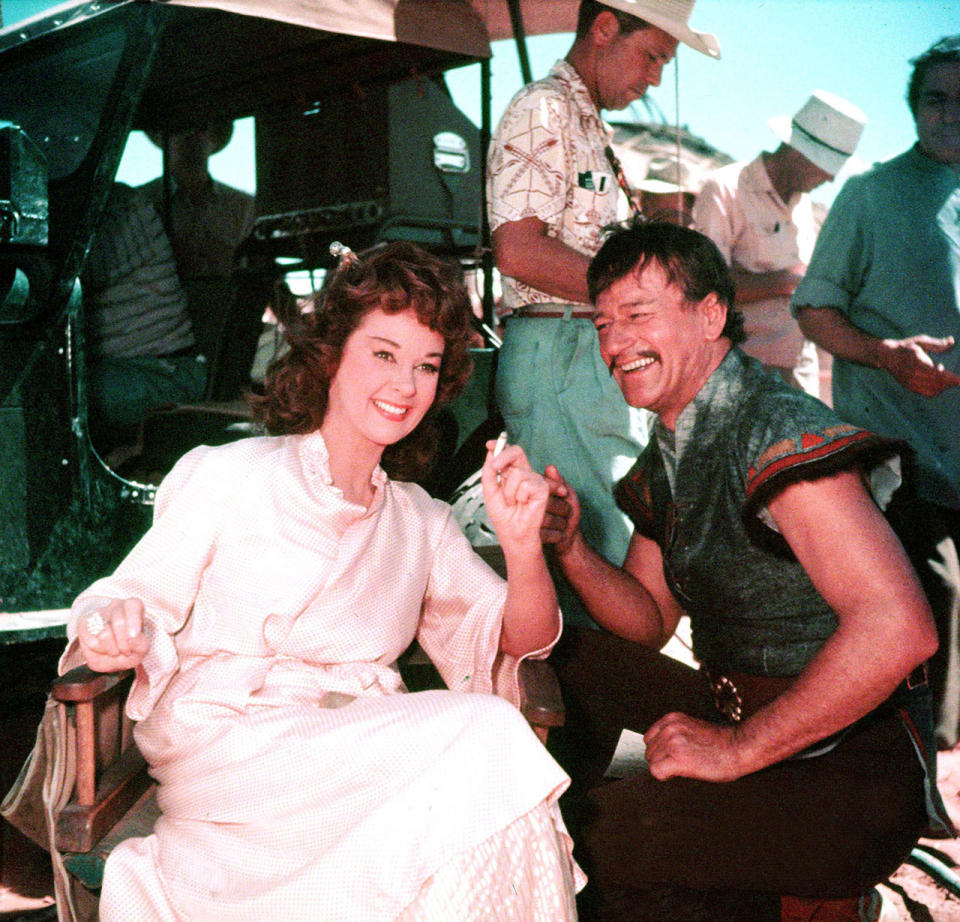The Conqueror: The story of the most toxic movie in Hollywood history

“Please God, don’t let us have killed John Wayne.” – The Pentagon
There are movies that have ended careers. There are movies that have ended studios. There are even some movies that have ended lives. Rarely do you find a movie that achieves all three. Dick Powell’s 1956 epic ‘The Conqueror’, however, was such a movie – a fatally miscast and directionless bore that forever tarnished the career of star John Wayne, bankrupted RKO Pictures and potentially contributed to the deaths of scores of its own cast and crew. Truly, it was the most toxic movie ever made – and its toxicity was felt for decades after its release.
Nobody sets out to make a bad movie, let alone one of the most critically reviled movies of all time, so to understand ‘The Conqueror’, you have to go back to see how bad decision upon bad decision led to it being made. The script – the story of the Mongol warlord who’d go on to become Genghis Khan – was written by Oscar Millard, writer of two acclaimed Robert Mitchum movies in the early ’50s. The film was apparently written with Marlon Brando in mind for the lead role; it was pure chance, however, that John Wayne – celebrated screen cowboy – came upon the script. Wayne had been visiting the office of filmmaker Dick Powell to go over scripts for the third of his three contracted pictures for RKO, when the director had to step out for a few minutes. When he came back in the room, Wayne was reading a screenplay he’d fished out of the bin. The bin is where ‘The Conqueror’ should have stayed.

Powell, for his part, tried to convince Wayne that he was ill-suited for the role of Temujin, the Asian warlord, but later admitted: “Who am I to turn down John Wayne?”
American actors playing foreign characters was not unheard of in the 50s, so nobody raised an eyebrow that Wayne was cast; in fact, Wayne’s eyes were ‘slanted’ with rubber bands and his face was covered in ‘yellowface’ makeup, topped off with a ‘Fu Manchu’ style moustache and beard – instant Asian, or so he thought. As sad as it seems, Wayne was taking the movie very seriously and crash dieted for the part, a role for which he would later be awarded a Golden Turkey award. Posthumously. Of the entire cast, only two men were actually of Asian descent and only one of them had any dialogue. Meanwhile, Navajo extras played Mongolian warriors, apparently not deemed worthy of makeup themselves.
The movie was bankrolled by famed producer Howard Hughes, who provided the budget of around $6 million. He decided ‘The Conqueror’ was to be filmed in Snow Canyon, Utah – a picturesque location for sure, but one that came with a caveat. The valley was downwind from the Yucca Flats near St George in Nevada, an area where 11 atom bombs had recently been tested as part of US military Operation Upshot-Knothole. Hughes and Powell knew about the nuclear tests – there are even pictures of John Wayne holding a geiger counter on the set – but the filmmakers were assured by the government that the recent tests would not be damaging to the health of the cast and crew.
Shooting quickly began to unravel. It was clear from Wayne’s delivery that the dialogue and its staccato delivery did not suit his Western drawl. Powell quickly lost faith in the movie and the quality control got sloppy. Wayne was on a form of amphetamines to help him cope with the intense heat, causing him to behave erratically. Under Hughes’ supervision, unscripted scenes wound up in the can, including a scene with a dancing bear, a sequence in which co-star Lee Van Cleef dances with his shirt off, and a bizarre background scene in which a black panther was drafted in and ended up nearly mauling the film’s lead actress Susan Hayward.

For 13 weeks, the cast and crew slogged away in Snow Canyon, the site used for all of the movie’s external locations, meaning several scenes meant to indicate travel both started and ended in the same place. When shooting returned to Hollywood, Hughes, ever the perfectionist, decided he wanted to ship 60 tonnes of the Utah dirt back to the studio lot to match the terrain of the external shots.
‘The Conqueror’ conquered nothing. Even before it hit cinemas, where it made an underwhelming $4.5m, it had garnered a reputation as a dud. Wayne hated the movie and cursed the day he ever picked the script out of Dick Powell’s rubbish basket, saying to reporters that the moral of the story was “not to make an ass of yourself trying to play parts you’re not suited for”. The movie’s lack of financial success put a huge dent in RKO Pictures, who ceased production in 1957, the year after ‘The Conqueror’s release. If the movie was destined to be remembered as a flop, that’d be one thing, but its legacy would end up being far more horrifying than that.
It soon became apparent that the federal government’s assurances on the safety of the Nevada nuclear tests were not to be trusted. Half of the residents of St George would go on to develop cancer due to radiation. A large number of ‘The Conqueror”s cast and crew would go on to develop cancer in the years immediately after filming. Co-star Pedro Armendáriz was diagnosed with kidney cancer in 1960 and shot himself upon learning it was terminal. Director Dick Powell died of cancer in 1963. The movie’s three leads, John Wayne, Susan Hayward and Agnes Moorhead, all died of cancer in the 1970s. Even people who had only visited the set were found to have been at a greater risk of cancer – John Wayne’s children both developed forms of cancer after just one day on the Utah set.

An investigation by People Magazine claimed that by the end of 1980, of the 220 people who worked on the movie, 91 of them had developed cancer and 46 of those had died from the disease. Dr Robert Pendleton, a biologist at the University of Utah, said in 1980: “In a group this size you’d expect only 30-some cancers to develop. With 91 cancer cases, I think the tie-in to their exposure on the set of ‘The Conqueror’ would hold up in a court of law.” The number is disproportionately high, even considering mitigating factors like Wayne’s six-packs-a-day smoking habit. The article even quoted the Pentagon’s Defense Nuclear Agency, tacitly admitting the government’s culpability in letting Powell and crew shoot in Snow Canyon. The movie was literally toxic and the fallout was devastating.
Howard Hughes was haunted by the decisions he’d made: first, in agreeing to shoot near a nuclear testing site, then in foolishly shipping the same radioactive dirt back to the studio lot. The producer told friends he felt “guilty as hell” about the cancer controversy, and subsequently bought every single print of the movie at a cost of $12 million – double the movie’s original budget – in order to keep it out of circulation. Hughes became obsessed with the movie, which was his last as a producer. He would watch it endlessly in his final paranoid days, every night before he went to bed, screened by a projectionist who was ordered to wear a blindfold so as not to subject himself to it. When Universal bought the rights to ‘The Conqueror’ in 1979, three years after Hughes’ death, it had not been seen by a member of the public for 21 years.
Hughes tried to suffocate it. Wayne tried to disown it. Powell tried to bin it. But ‘The Conqueror’ was a movie so bad, so ill-conceived and so irresponsibly created, it could not be contained. A tragic tale of hubris, ego and health hazards, the film left bodies in its wake and scorch marks on Hollywood for decades to come.

 Yahoo Movies
Yahoo Movies 
